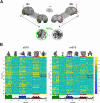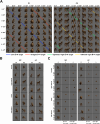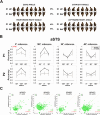Integration of head and body orientations in the macaque superior temporal sulcus is stronger for upright bodies
- PMID: 40421707
- PMCID: PMC12113281
- DOI: 10.7554/eLife.105714
Integration of head and body orientations in the macaque superior temporal sulcus is stronger for upright bodies
Abstract
The neural processing of faces and bodies is often studied separately, despite their natural integration in perception. Unlike prior research on the neural selectivity for either head or body orientation, we investigated their interaction in macaque superior temporal sulcus (STS) using a monkey avatar with diverse head-body orientation angles. STS neurons showed selectivity for specific combinations of head-body orientations. Anterior STS (aSTS) neurons enabled more reliable decoding of head-body configuration angles compared to middle STS neurons. Decoding accuracy in aSTS was lowest for head-body angle pairs differing only in sign (e.g. head-body orientation difference of ±90° relative to the anatomical midline), and highest for aligned (0°) head-body orientations versus those with maximum angular difference. Inverted bodies showed diminished decoding of head-body orientation angle compared to upright bodies. These findings show that aSTS integrates head and body orientation cues, revealing configuration-specific neural mechanisms, and advance our understanding of social perception.
Keywords: bodies; faces; head–body interaction; inferior temporal cortex; neuroscience; rhesus macaque; superior temporal sulcus.
© 2025, Zafirova and Vogels.
Conflict of interest statement
YZ, RV No competing interests declared
Figures


















Update of
- doi: 10.1101/2024.12.30.630733
- doi: 10.7554/eLife.105714.1
- doi: 10.7554/eLife.105714.2
References
-
- de Gelder B, Van den Stock J, Meeren HKM, Sinke CBA, Kret ME, Tamietto M. Standing up for the body: recent progress in uncovering the networks involved in the perception of bodies and bodily expressions. Neuroscience & Biobehavioral Reviews. 2010;34:513–527. doi: 10.1016/j.neubiorev.2009.10.008. - DOI - PubMed
MeSH terms
Grants and funding
LinkOut - more resources
Full Text Sources

